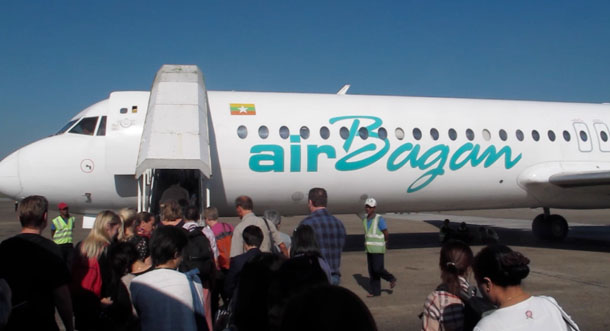RANGOON – Financial backing from the private sector is needed to link Burma’s proposed new international airport at Hanthawaddy with Rangoon, the country’ biggest city, government officials said.
“We propose a highway and a high-speed train to Yangon,” Kyaw Soe, an official at the Department of Civil Aviation, told The Irrawaddy. Unable to put a number on the likely cost of building the new transport links, Kyaw Soe counseled that “We need investors to do this; it is just a proposal at the moment.”
The construction of the new airport — aiming to cater for 12 million passengers per year at Hanthawaddy, all of 80km north of Rangoon — will be undertaken by a consortium led by South Korea’s Incheon, which won a government tender for the project on Aug 12.
The new airport will be needed, the government has said, to meet growing tourist interest in the country. By 2020, visitor numbers could be anywhere from 2.8 million to 7.4 million, up from 1 million last year, according to official estimates. The top-end projections for an expanded tourism sector would be worth over US$10 billion per annum to Burma’s economy — a massive jump from the approximately 1 million tourist that visited last year.
The transport plans for the new airport would not just link to Rangoon, Burma’s commercial hub and a city expected to double in size to 10 million by 2040, but also include a road link to the giant Japanese-backed Thilawa industrial park, the Transport Ministry says.
“We have a masterplan for Hanthawaddy airport which includes a plan to link to Thilawa,” said Min Lwin, Head of Office at the Transport Ministry. Thilawa, currently a port located about 25 km from downtown Rangoon, will be a 2,400-hectare “special economic zone.”
The proposed SEZ is key to attracting large-scale Japanese manufacturing to Burma, as it will provide a work-around for companies interested in setting up shop in the country but deterred by Rangoon’s infrastructure deficits — such as a lack of office space, high land prices and unreliable electricity supply.
“We expect that they will break ground at Thilawa in December,” Masaki Takahara, director of JETRO, Japan’s overseas trade mission in Rangoon, told The Irrawaddy.
Construction of the zone, slated to be finished by 2015, will be a 51-49 percent joint venture between Burmese companies and Japanese counterparts, featuring corporate giants Mitsubishi, Sumitomo and Marubeni.
Min Lwin could not give any details about whether the Hanthawaddy-Thilawa link would comprise rail as well as road, or how the proposed connection would dovetail with existing road and rail connections into Rangoon. Japan’s Itochu Corporation will, however, build a bridge linking Rangoon to Thilawa, according The Construction Ministry.
“We have formed the implementation committee and will discuss this in the future,” Min Lwin says, adding that the Transport Ministry will meet with the Incheon-led consortium in September to discuss the overall airport project, which will be comprised of three phases – building the airport, construction of an adjacent ‘airport city’ and the upgrading of transport links to Thilawa.
Aside from the new Hanthawaddy international airport, two other airport projects – the expansion and upgrading of Rangoon’s current international airport and the airport at Mandalay, will be carried out in Burma in the coming years.
The existing Rangoon airport will be upgraded – mainly to cater for domestic flights – by Pioneer Aerodrome Services (PAS), while Japan’s Mitsubishi-Jalux will expand Mandalay’s airport. PAS is linked to Asia World, run by Steven Law, a US-sanctioned businessman who is the son of recently-deceased drug trafficker Lo Hsing Han.
















